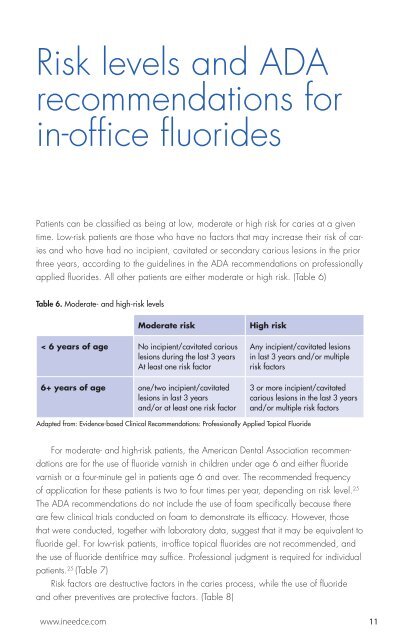You also want an ePaper? Increase the reach of your titles
YUMPU automatically turns print PDFs into web optimized ePapers that Google loves.
Risk levels and ADA<br />
re<strong>com</strong>mendations for<br />
in-office fluorides<br />
Patients can be classified as being at low, moderate or high risk for caries at a given<br />
time. Low-risk patients are those who have no factors that may increase their risk of caries<br />
and who have had no incipient, cavitated or secondary carious lesions in the prior<br />
three years, according to the guidelines in the ADA re<strong>com</strong>mendations on professionally<br />
applied fluorides. All other patients are either moderate or high risk. (Table 6)<br />
Table 6. Moderate- and high-risk levels<br />
Moderate risk<br />
< 6 years of age No incipient/cavitated carious<br />
lesions during the last 3 years<br />
At least one risk factor<br />
6+ years of age one/two incipient/cavitated<br />
lesions in last 3 years<br />
and/or at least one risk factor<br />
High risk<br />
Any incipient/cavitated lesions<br />
in last 3 years and/or multiple<br />
risk factors<br />
3 or more incipient/cavitated<br />
carious lesions in the last 3 years<br />
and/or multiple risk factors<br />
Adapted from: Evidence-based Clinical Re<strong>com</strong>mendations: Professionally Applied Topical <strong>Fluoride</strong><br />
For moderate- and high-risk patients, the American Dental Association re<strong>com</strong>mendations<br />
are for the use of fluoride varnish in children under age 6 and either fluoride<br />
varnish or a four-minute gel in patients age 6 and over. The re<strong>com</strong>mended frequency<br />
of application for these patients is two to four times per year, depending on risk level. 25<br />
The ADA re<strong>com</strong>mendations do not include the use of foam specifically because there<br />
are few clinical trials conducted on foam to demonstrate its efficacy. However, those<br />
that were conducted, together with laboratory data, suggest that it may be equivalent to<br />
fluoride gel. For low-risk patients, in-office topical fluorides are not re<strong>com</strong>mended, and<br />
the use of fluoride dentifrice may suffice. Professional judgment is required for individual<br />
patients. 25 (Table 7)<br />
Risk factors are destructive factors in the caries process, while the use of fluoride<br />
and other preventives are protective factors. (Table 8)<br />
www.ineedce.<strong>com</strong> 11

















